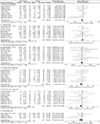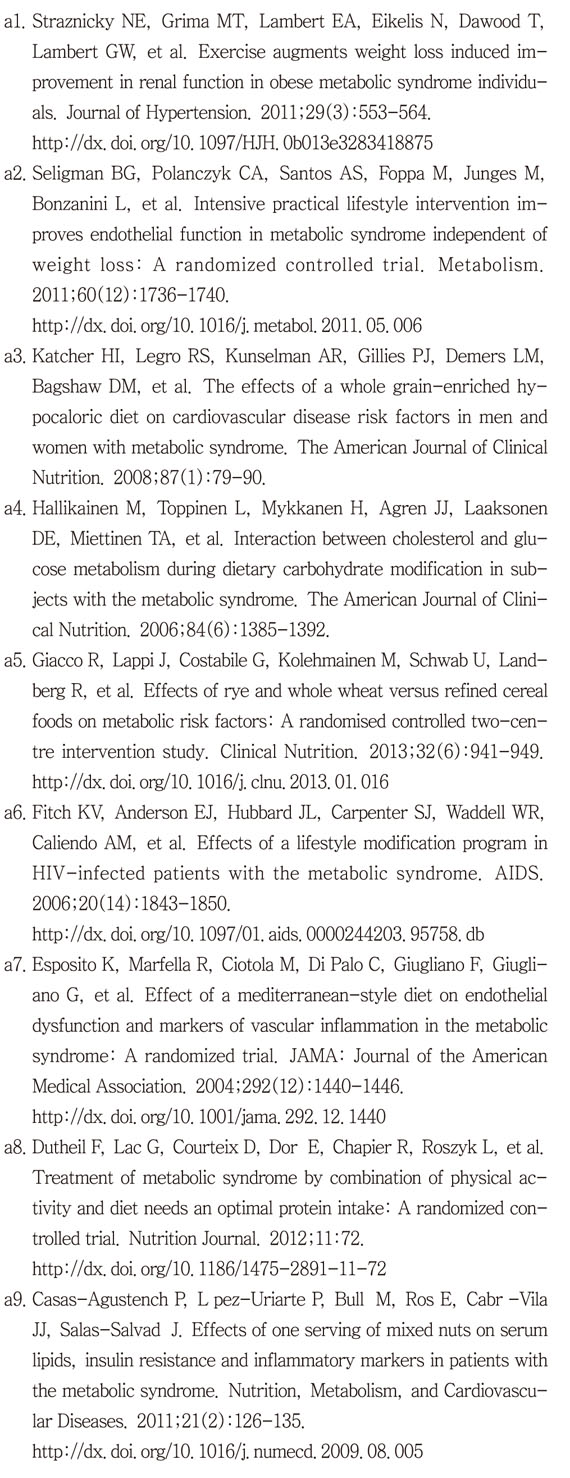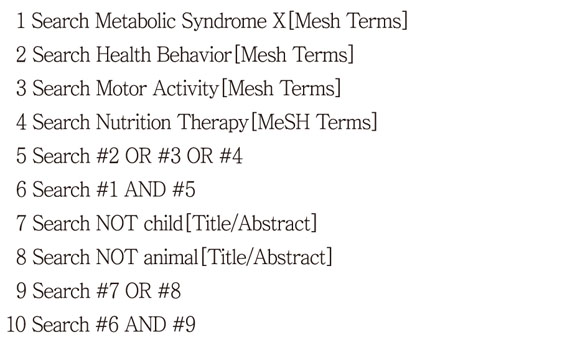1. National Cholesterol Education Program (NCEP) Expert Panel on Detection, Evaluation, and Treatment of High Blood Cholesterol in Adults (Adult Treatment Panel III). Third report of the national cholesterol education program (NCEP) Expert panel on detection, evaluation, and treatment of high blood cholesterol in adults (Adult Treatment Panel III) final report. Circulation. 2002; 106(25):3143–3421.
3. Alberti KG, Zimmet PZ. Definition, diagnosis and classification of diabetes mellitus and its complications. Part 1: Diagnosis and classification of diabetes mellitus provisional report of a WHO consultation. Diabet Med. 1998; 15(7):539–553. DOI:
10.1002/(sici)1096-9136(199807)15:7<539::aid-dia668>3.0.co;2-s.
5. Kim E, Oh SW. Gender differences in the association of occupation with metabolic syndrome in Korean adults. Korean J Obes. 2012; 21(2):108–114. DOI:
10.7570/kjo.2012.21.2.108.
6. Gami AS, Witt BJ, Howard DE, Erwin PJ, Gami LA, Somers VK, et al. Metabolic syndrome and risk of incident cardiovascular events and death: A systematic review and meta-analysis of longitudinal studies. J Am Coll Cardiol. 2007; 49(4):403–414. DOI:
10.1016/j.jacc.2006.09.032.
8. Kelley DE, Wing R, Buonocore C, Sturis J, Polonsky K, Fitzsimmons M. Relative effects of calorie restriction and weight loss in noninsulin-dependent diabetes mellitus. J Clin Endocrinol Metab. 1993; 77(5):1287–1293. DOI:
10.1210/jcem.77.5.8077323.
9. Pitsavos C, Panagiotakos D, Weinem M, Stefanadis C. Diet, exercise and the metabolic syndrome. Rev Diabet Stud. 2006; 3(3):118–126. DOI:
10.1900/rds.2006.3.118.
10. Jenkins DJ, Kendall CW, Augustin LS, Franceschi S, Hamidi M, Marchie A, et al. Glycemic index: overview of implications in health and disease. Am J Clin Nutr. 2002; 76(1):266S–273S.
11. Kastorini CM, Milionis HJ, Esposito K, Giugliano D, Goudevenos JA, Panagiotakos DB. The effect of mediterranean diet on metabolic syndrome and its components: A meta-analysis of 50 studies and 534,906 individuals. J Am Coll Cardiol. 2011; 57(11):1299–1313. DOI:
10.1016/j.jacc.2010.09.073.
12. Blanco Mejia S, Kendall CW, Viguiliouk E, Augustin LS, Ha V, Cozma AI, et al. Effect of tree nuts on metabolic syndrome criteria: A systematic review and meta-analysis of randomised controlled trials. BMJ Open. 2014; 4(7):e004660. DOI:
10.1136/bmjopen-2013-004660.
13. Jansen S, Lopez-Miranda J, Salas J, Castro P, Paniagua JA, Lopez-Segura F, et al. Plasma lipid response to hypolipidemic diets in young healthy non-obese men varies with body mass index. J Nutr. 1998; 128(7):1144–1149.
14. Schwingshackl L, Dias S, Strasser B, Hoffmann G. Impact of different training modalities on anthropometric and metabolic characteristics in overweight/obese subjects: A systematic review and network meta-analysis. PLoS One. 2013; 8(12):e82853. DOI:
10.1371/journal.pone.0082853.
15. Dunkley AJ, Charles K, Gray LJ, Camosso-Stefinovic J, Davies MJ, Khunti K. Effectiveness of interventions for reducing diabetes and cardiovascular disease risk in people with metabolic syndrome: Systematic review and mixed treatment comparison meta-analysis. Diabetes Obes Metab. 2012; 14(7):616–625. DOI:
10.1111/j.1463-1326.2012.01571.x.
16. Higgins JPT, Green S, editors. Cochrane handbook for systematic reviews of interventions: Version 5.1.0 [Internet]. London, UK: The Cochrane Collaboration;2011. cited 2014 September 5. Available from:
www.cochrane-handbook.org.
17. Reaven GM. Banting lecture 1988. Role of insulin resistance in human disease. Diabetes. 1988; 37(12):1595–1607.
19. U.S. National Library of Medicine. MeSH: Nutrition therapy [Internet]. Bethesda, MD: Author;2004. cited 2014 October 30. Available from:
www.ncbi.nlm.nih.gov/mesh/68044623.
20. Moher D, Liberati A, Tetzlaff J, Altman DG. Preferred reporting items for systematic reviews and meta-analyses: The PRISMA statement. PLoS Med. 2009; 6(7):e1000097. DOI:
10.1371/journal.pmed.1000097.
22. Straznicky NE, Grima MT, Lambert EA, Eikelis N, Dawood T, Lambert GW, et al. Exercise augments weight loss induced improvement in renal function in obese metabolic syndrome individuals. J Hypertens. 2011; 29(3):553–564. DOI:
10.1097/HJH.0b013e3283418875.
23. Seligman BG, Polanczyk CA, Santos AS, Foppa M, Junges M, Bonzanini L, et al. Intensive practical lifestyle intervention improves endothelial function in metabolic syndrome independent of weight loss: A randomized controlled trial. Metabolism. 2011; 60(12):1736–1740. DOI:
10.1016/j.metabol.2011.05.006.
24. Dutheil F, Lac G, Courteix D, Dore E, Chapier R, Roszyk L, et al. Treatment of metabolic syndrome by combination of physical activity and diet needs an optimal protein intake: A randomized controlled trial. Nutr J. 2012; 11:72. DOI:
10.1186/1475-2891-11-72.
25. Katcher HI, Legro RS, Kunselman AR, Gillies PJ, Demers LM, Bagshaw DM, et al. The effects of a whole grain-enriched hypocaloric diet on cardiovascular disease risk factors in men and women with metabolic syndrome. Am J Clin Nutr. 2008; 87(1):79–90.
26. Giacco R, Lappi J, Costabile G, Kolehmainen M, Schwab U, Landberg R, et al. Effects of rye and whole wheat versus refined cereal foods on metabolic risk factors: A randomised controlled two-centre intervention study. Clin Nutr. 2013; 32(6):941–949. DOI:
10.1016/j.clnu.2013.01.016.
27. Hallikainen M, Toppinen L, Mykkanen H, Agren JJ, Laaksonen DE, Miettinen TA, et al. Interaction between cholesterol and glucose metabolism during dietary carbohydrate modification in subjects with the metabolic syndrome. Am J Clin Nutr. 2006; 84(6):1385–1392.
28. Fitch KV, Anderson EJ, Hubbard JL, Carpenter SJ, Waddell WR, Caliendo AM, et al. Effects of a lifestyle modification program in HIV-infected patients with the metabolic syndrome. AIDS. 2006; 20(14):1843–1850. DOI:
10.1097/01.aids.0000244203.95758.db.
29. Esposito K, Marfella R, Ciotola M, Di Palo C, Giugliano F, Giugliano G, et al. Effect of a mediterranean-style diet on endothelial dysfunction and markers of vascular inflammation in the metabolic syndrome: A randomized trial. JAMA. 2004; 292(12):1440–1446. DOI:
10.1001/jama.292.12.1440.
30. Casas-Agustench P, López-Uriarte P, Bulló M, Ros E, Cabré-Vila JJ, Salas-Salvadó J. Effects of one serving of mixed nuts on serum lipids, insulin resistance and inflammatory markers in patients with the metabolic syndrome. Nutr Metab Cardiovasc Dis. 2011; 21(2):126–135. DOI:
10.1016/j.numecd.2009.08.005.








 PDF
PDF ePub
ePub Citation
Citation Print
Print





 XML Download
XML Download